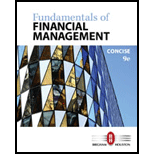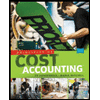
Bundle: Fundamentals of Financial Management, Concise Edition, Loose-leaf Version, 9th + Aplia, 1 term Printed Access Card
9th Edition
ISBN: 9781337089241
Author: Eugene F. Brigham, Joel F. Houston
Publisher: Cengage Learning
expand_more
expand_more
format_list_bulleted
Concept explainers
Question
Chapter 15, Problem 4Q
Summary Introduction
To explain: The cash budget and its use in reduction of cash and in negotiating a loan and advantage and disadvantage of daily cash budgets over monthly cash budget.
Introduction:
Cash:
Cash is always reported under the head of current assets in the balance sheet of a company. It is treated as current asset because any asset which can be report in the form of cash within a period of 1 financial year is classified as current asset and cash is already presented in the form of cash.
Expert Solution & Answer
Want to see the full answer?
Check out a sample textbook solution
Students have asked these similar questions
i submitted blurr images mistakely don't amswer.If image is blurr comment please i will write values .
dont give answer with incorrect values.
i will unhelpful answer
Need help!!!If image is blurr comment please i will write values .
dont give answer with incorrect values.
i will unhelpful answer
help !If image is blurr comment please i will write values .
dont give answer with incorrect values.
i will unhelpful answer
Chapter 15 Solutions
Bundle: Fundamentals of Financial Management, Concise Edition, Loose-leaf Version, 9th + Aplia, 1 term Printed Access Card
Ch. 15 - What are some pros and cons of holding high levels...Ch. 15 - Prob. 2QCh. 15 - What are the two definitions of cash, and why do...Ch. 15 - Prob. 4QCh. 15 - What are the four key factors in a firms credit...Ch. 15 - Prob. 6QCh. 15 - Why is some trade credit called free while other...Ch. 15 - Define each of the following loan terms, and...Ch. 15 - Prob. 9QCh. 15 - Indicate using a (+), (), or (0) whether each of...
Ch. 15 - CASH CONVERSION CYCLE Parramore Corp has 12...Ch. 15 - Prob. 2PCh. 15 - COST OF TRADE CREDIT AND BANK LOAM Lancaster...Ch. 15 - CASH CONVERSION CYCLE Zane Corporation has an...Ch. 15 - RECEIVABLES INVESTMENT McEwan Industries sells on...Ch. 15 - WORKING CAPITAL INVESTMENT Pasha Corporation...Ch. 15 - CASH CONVERSION CYCLE Chastain Corporation is...Ch. 15 - CURRENT ASSETS INVESTMENT POLICY Rentz Corporation...Ch. 15 - Prob. 9PCh. 15 - CASH BUDGETING Helen Bowers, owner of Helens...Ch. 15 - CASH BUDGETING Rework problem 15-10 using a...Ch. 15 - Prob. 12IC
Knowledge Booster
Learn more about
Need a deep-dive on the concept behind this application? Look no further. Learn more about this topic, finance and related others by exploring similar questions and additional content below.Similar questions
- Listed here, are the 2018 and 2019 balance sheets. motors. and income statements,, for Otago Bay Marine Motors, a major manufacturer of top-of-the-line outboard a. On the basis of the information provided, calculate the following financial ratios for 2018 and 2019: b. Considering the financial ratios you computed, along with the industry averages, how would you characterize the financial condition of Otago Bay Marine Motors? Explain. a. Calculate the following financial ratios for 2018 and 2019. (Round to two decimal places.) Current ratio Otago Bay Marine Motors 2019 2018arrow_forwardI need to get more details by doing homeworks and exams.arrow_forwardUse the financial statement of DKT Enterprise provided above to calculate the ratio for 2024 that reflects each of the following conditions (where applicable, round off answers to two decimal places.): 1. The percentage of DKT Enterprises' revenue that remained after accounting for the cost of goods sold. 2. The percentage of DKT Enterprises' revenue that remained after all expenses, including operating costs, interest, and taxes, have been deducted. 3. The extent to which DKT Enterprises' short-term liabilities, were covered by assets that could be quickly converted into cash during the year. 4. The ratio of DKT Enterprises' liquid assets to its current liabilities, indicating the company's ability to meet short-term obligations without relying on inventory. 5. The percentage of the profit DKT Enterprises generated from its total assets during the year, reflecting how efficiently it utillises its asset base to generate earnings. 6. The percentage of the profit for the year relative…arrow_forward
- Dynamic Energy Wares (DEW) has decided to change the manner in which it distributes its products to large companies. The change in the distribution system comes at a time when DEW’s profits are declining. The declining profits might not be the sole reason for the change, but it appears to be the primary impetus for the decision. It also appears that the new policy requiring DEW’s distributors to increase inventory levels before the end of the fiscal year will artificially inflate DEW’s sales for the current year. However, DEW’s new policy does not require the distributors to pay for any increased inventory until next year (six months), and any unsold inventory can be returned after nine months. So, if the demand for DEW’s products actually is decreasing, the impact will appear on next year’s financial statements. If the financial manager actually intends to artificially inflate DEW’s profits this year, she must realize that such actions eventually will “catch up” with her. Discussion…arrow_forwardwhat is distributors’ meeting?arrow_forwardWhat is ethical dilemma?arrow_forward
- $1.35 Million for the below question is incorrect, Machine A is $1.81 and Machine B is $0.46 Million. The Perez Company has the opportunity to invest in one of two mutually exclusive machines that will produce a product it will need for the foreseeable future. Machine A costs $8 million but realizes after-tax inflows of $4.5 million per year for 4 years. After 4 years, the machine must be replaced. Machine B costs $17 million and realizes after-tax inflows of $4 million per year for 8 years, after which it must be replaced. Assume that machine prices are not expected to rise because inflation will be offset by cheaper components used in the machines. The cost of capital is 13%. Using the replacement chain approach to project analysis, by how much would the value of the company increase if it accepted the better machine? Round your answer to two decimal places. 1.) $1.35 millionarrow_forwardBuggies-Are-Us Steady Freddie, Inc Gang Buster Group g = 0 g = 55% Year 1 $3.51 (i.e., dividends are expected to remain at $3.053.05/share) (for the foreseeable future) Year 2 $4.04 Year 3 $4.63 Year 4 $5.36 Year 5 $6.15 Year 6 and beyond: g = 55%arrow_forwardProject S has a cost of $10,000 and is expected to produce benefits (cash flows) of $3,000 per year for 5 years. Project L costs $25,000 and is expected to produce cash flows of $7,400 per year for 5 years. Calculate the two projects' NPVs, assuming a cost of capital of 12%. Do not round intermediate calculations. Round your answers to the nearest cent. Calculate the two projects' PIs, assuming a cost of capital of 12%. Do not round intermediate calculations. Round your answers to three decimal places. Project L is not 1.07arrow_forward
- Wilbur and Orville are brothers. They're both serious investors, but they have different approaches to valuing stocks. Wilbur, the older brother, likes to use the dividend valuation model. Orville prefers the free cash flow to equity valuation model. As it turns out, right now, both of them are looking at the same stock-Wright First Aerodynmaics, Inc. (WFA). The company has been listed on the NYSE for over 50 years and is widely regarded as a mature, rock-solid, dividend-paying stock. The brothers have gathered the following information about WFA's stock: Current dividend (D) = $2.30/share Current free cash flow (FCF) = $1.5 million Expected growth rate of dividends and cash flows (g) = 5% Required rate of return (r) = 14% Shares outstanding 500,000 shares How would Wilbur and Orville each value this stock?arrow_forwardCompany P/S Multiples Facebook 13.33 Snap 18.22 Twitter 13.27arrow_forwardThe Perez Company has the opportunity to invest in one of two mutually exclusive machines that will produce a product it will need for the foreseeable future. Machine A costs $8 million but realizes after-tax inflows of $4.5 million per year for 4 years. After 4 years, the machine must be replaced. Machine B costs $17 million and realizes after-tax inflows of $4 million per year for 8 years, after which it must be replaced. Assume that machine prices are not expected to rise because inflation will be offset by cheaper components used in the machines. The cost of capital is 13%. Using the replacement chain approach to project analysis, by how much would the value of the company increase if it accepted the better machine? Round your answer to two decimal places. 1.) $ millionarrow_forward
arrow_back_ios
SEE MORE QUESTIONS
arrow_forward_ios
Recommended textbooks for you
 Intermediate Financial Management (MindTap Course...FinanceISBN:9781337395083Author:Eugene F. Brigham, Phillip R. DavesPublisher:Cengage Learning
Intermediate Financial Management (MindTap Course...FinanceISBN:9781337395083Author:Eugene F. Brigham, Phillip R. DavesPublisher:Cengage Learning Principles of Cost AccountingAccountingISBN:9781305087408Author:Edward J. Vanderbeck, Maria R. MitchellPublisher:Cengage Learning
Principles of Cost AccountingAccountingISBN:9781305087408Author:Edward J. Vanderbeck, Maria R. MitchellPublisher:Cengage Learning- Principles of Accounting Volume 2AccountingISBN:9781947172609Author:OpenStaxPublisher:OpenStax College
 EBK CONTEMPORARY FINANCIAL MANAGEMENTFinanceISBN:9781337514835Author:MOYERPublisher:CENGAGE LEARNING - CONSIGNMENT
EBK CONTEMPORARY FINANCIAL MANAGEMENTFinanceISBN:9781337514835Author:MOYERPublisher:CENGAGE LEARNING - CONSIGNMENT


Intermediate Financial Management (MindTap Course...
Finance
ISBN:9781337395083
Author:Eugene F. Brigham, Phillip R. Daves
Publisher:Cengage Learning

Principles of Cost Accounting
Accounting
ISBN:9781305087408
Author:Edward J. Vanderbeck, Maria R. Mitchell
Publisher:Cengage Learning

Principles of Accounting Volume 2
Accounting
ISBN:9781947172609
Author:OpenStax
Publisher:OpenStax College

EBK CONTEMPORARY FINANCIAL MANAGEMENT
Finance
ISBN:9781337514835
Author:MOYER
Publisher:CENGAGE LEARNING - CONSIGNMENT